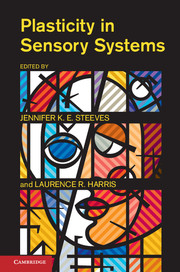Book contents
- Frontmatter
- Contents
- List of Contributors
- 1 Plasticity in Sensory Systems
- I VISUAL AND VISUOMOTOR PLASTICITY
- II PLASTICITY IN CHILDHOOD
- III PLASTICITY IN ADULTHOOD AND VISION REHABILITATION
- 9 Visual Plasticity of the Adult Brain
- 10 Beyond the Critical Period: Acquiring Stereopsis in Adulthood
- 11 Plasticity and Restoration after Visual System Damage: Clinical Applications of the “Residual Vision Activation Theory”
- 12 Applying Plasticity to Visual Rehabilitation in Adulthood
- Author Index
- Subject Index
- References
9 - Visual Plasticity of the Adult Brain
from III - PLASTICITY IN ADULTHOOD AND VISION REHABILITATION
Published online by Cambridge University Press: 05 January 2013
- Frontmatter
- Contents
- List of Contributors
- 1 Plasticity in Sensory Systems
- I VISUAL AND VISUOMOTOR PLASTICITY
- II PLASTICITY IN CHILDHOOD
- III PLASTICITY IN ADULTHOOD AND VISION REHABILITATION
- 9 Visual Plasticity of the Adult Brain
- 10 Beyond the Critical Period: Acquiring Stereopsis in Adulthood
- 11 Plasticity and Restoration after Visual System Damage: Clinical Applications of the “Residual Vision Activation Theory”
- 12 Applying Plasticity to Visual Rehabilitation in Adulthood
- Author Index
- Subject Index
- References
Summary
Historical Preamble
When I arrived in Cambridge in the late 1970s to work with the late Fergus Campbell, the notion of critical periods for visual development was already well established through the seminal works of Hubel and Wiesel (1967), Blakemore (1976), and others (see Daw, 1995). The clinical implication of this was also recognized, namely, that visual improvements from the patching treatment of amblyopia were likely to be strongly age dependent and ineffective after the age of 7 to 8 years. At that time, the wisdom of Sir Stewart Duke-Elder held sway: “for patching to work it needs to be total and complete, day and night.” Fergus always felt that the stronger the statement, the more likely it was to be wrong. In fact, at that time, I remember his method for choosing research projects for graduate students. He would go to his bookshelf and choose at random one of Duke-Elder's System of Ophthalmology volumes, open it at random and locate a definitive statement on some visual topic. “Let's show this is wrong,” he would say, and the die was cast for what usually turned out to be another fruitful piece of research.
Fergus felt that some form of active stimulation would be better than the passive viewing that resulted from patching. He was enamored with the idea of the visual cortex as a spatial frequency analyzer, and because my early results suggested amblyopes suffered from severe spatial distortions (Hess et al., 1978), his first suggestion for a new therapy was to show a single spatial frequency at sequential orientations to help their visual cortex “sort out” what we hypothesized were anomalous interactions between these spatial analysers.
- Type
- Chapter
- Information
- Plasticity in Sensory Systems , pp. 155 - 174Publisher: Cambridge University PressPrint publication year: 2012



